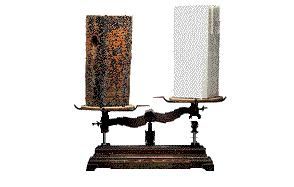
Measuring mass and weight
Dr. Walt Volland all rights reserved revised July 1, 2013,
How do we measure weight? One way is to use a spring scale.
The spring scale has a spring that stretches when an object is attached to it. The amount of stretching increases with increasing weight. We use standard weights to calibrate the stretch of the spring. An object that stretches the spring the same distance a standard weight does has the same weight as the standard. If the sample stretches the spring half the distance that the standard did then the object weighs half as much. Hmmm! Is it this easy?

NO, This method would run the risk of changing readings as the spring aged and possibly because the spring doesn't stretch proportionally with increasing loads. For weight measurements that are close together a single calibrating weight may be good enough. For measurements of objects over a large range of weight multiple calibration weights may be needed. The use of more than one weight is important because the spring stretching may not be proportional to the weight. It is true that an object that stretches the spring the same distance that the standard weight does weighs the same as the standard weight.
Will a spring scale give the same weight reading everywhere? No, it won't because gravitational forces can change with location. See the
Supermarkets use spring scales in their produce departments. The scales are cheap and do not need to be particularly accurate. The scales have a coiled spring are are used over a range of a few pounds. Technically these scales should be calibrated regularly and often have a certificate or tag telling when the calibration was done. The check stands where we pay for the produce have a much more accurate electronic scale. The check stand is where we find out the accurate weight for how much we are really buying.
You know that the deli department uses electronic scales when weighing cold cuts, cheese, etc. Those weights are connected to a price data base just like the check stands. The scale automatically weighs and figures the price. The scales used in the deli have calibration tags that say they were checked for accuracy.
Digital electronic scales do not have the same problems of a spring scale. They have no springs. They depend on a sensor that generates a voltage when subjected to a force. They do not measure mass.
Mass is measured using balances. The mass of an object is directly compared with the mass of standards. An old fashioned double pan balance is shown here. The unknown object is matched with a series of known masses until the two masses are 'balanced'.

Masses are measured when you want a consistent amount of stuff like gold, Au, or platinum, Pt. When gold is worth $1800 per ounce no one wants inaccuracy. The mass of a object is the same everywhere. Location makes no difference.
A double pan balance allows us to measure mass. The masses of two objects are compared with one another at the same location. The effects of gravity are cancelled out because the two experience the same gravitational force.
The SI system defines mass in terms of the kilogram. Pharmacy and chemistry use much smaller quantities. This means pharmacists and chemists typically use amount in the gram or milligram range. We do this both for convenience and economic reasons. Chemistry labs frequently use micro scale amounts to minimize the cost of materials and also to reduce disposal problems. We use benign materials in all of our labs so disposal is not an issue.
Industrial scale processes use devices that measure amounts in tons if not thousands of tons of reactants and products. The scale (pun intended) of margarine production in the world is immense. No one is counting milligrams of margarine.
